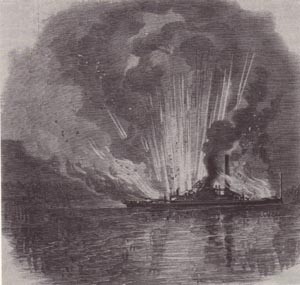CSS Curlew
CSS Curlew was an iron-hull North Carolina Sounds paddlewheel steamboat that was taken into the Confederate Navy in 1861. It was run aground at Fort Forrest (35°53′08″N 75°45′41″W / 35.88565°N 75.76131°WCoordinates: 35°53′08″N 75°45′41″W / 35.88565°N 75.76131°W) and burned in the battle for Roanoke Island on February 8, 1862. Its wreck was discovered in 1988 and archaeologically investigated in 1994.
The Curlew was built in 1856 by the Harlan & Hollingsworth Iron Shipbuilding Company of Wilmington, Delaware. It was 135 feet (41 m) long, 23 feet (7.0 m) wide, 8-foot (2.4 m) depth of hold, and listed at 236 tons. Its average draft was 5 feet (1.5 m), which suited the shallow waters of the North Carolina sounds. The steamboat had side paddle wheels that were 18 feet (5.5 m) in diameter by 8 feet (2.4 m) wide. The Curlew had no figurehead, a round stern, and no mast. A walking beam engine with a 29-inch (740 mm) diameter cylinder and a 9-foot (2.7 m) stroke powered the new steamer. This type of engine had a distinctive trapezoid-shaped rocker arm mounted between the paddle wheels, which transmitted power from the piston rod to the crank on the paddle wheel shaft. For improved efficiency, the Curlew's engine was equipped with Sickle's patented cutoff valve. Steam was provided by a two furnace return-flue boiler 18 feet (5.5 m) long, 7 feet (2.1 m) high, and 8 feet (2.4 m) wide, and rated at 30 lbf/in² (210 kPa) of pressure. It started operating in North Carolina in July 1856. (Olson 1997:30ff)
...
Wikipedia

